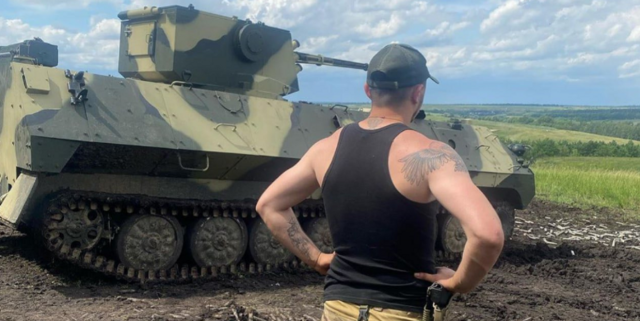Everyone is talking about tanks, but the role of the BMP in combat is no less, the author of the article in Forbes believes. Such homemade combat vehicles began to be built in Ukraine on the basis of an old tracked tractor MT-LB. How many MT-LB-BM-7 Ukrainians will be able to produce depends on the towers, not on the hull, since there are few of them.
David Ex
The Ukrainian parade of homemade infantry fighting vehicles continues. The last BMP from the do-it-yourself series in service with the AFU was the old MT-LB tracked tractor with a new turret.
At the same time, thanks to the remotely controlled BM-7 MT-LB tower, it can become the most heavily armed of all Ukrainian infantry fighting vehicles assembled in emergency mode.
The BM-7 turret, which is also mounted on Ukrainian wheeled BMP BTR-4, boasts a stabilized 30-millimeter automatic cannon. The gunner takes aim by video transmission from the body of the car. The rapid-fire cannon pierces trees, buildings and even concrete walls.
Of course, no sane commander will not send a lightly protected "motorcycle" with 10 mm armor into a frontal battle with tanks or even enemy infantry fighting vehicles. Even a well-aimed machine gunner will be able to hole the MT-LB, if he gets the opportunity.
However, the stabilized BM-7 automatic cannon made the BTR-4 one of the best Ukrainian infantry support vehicles for chaotic urban battles, where maneuverability and rate of fire — that is, the ability to react quickly to surprises — is sometimes more important than armor.
Nothing can prevent the MT-LB-BM-7 from becoming an excellent machine for urban conditions. The main thing is not to even try to rush it through a minefield or a pre—targeted artillery zone of destruction: the tractor simply will not be able to protect three crew members — and not to mention ten passengers.
Ukrainians are already using spare MT-LB chassis, which the Ukrainian industry produced serially from the 1970s to the early 2000s, and this speaks volumes about the needs of Kiev in the protracted conflict, approaching the one and a half year milestone.
Tanks are on everyone's lips, but the role of the BMP is no less. Over the seven weeks of Ukraine's long-awaited counteroffensive in the south, it is becoming increasingly obvious that the very density of defensive fortifications along an almost thousand-kilometer front practically excludes quick and long-range maneuvers on both sides.
Therefore, the advancing forces are moving slowly, and the infantry often moves on foot accompanied by equipment, trying not to miss the slightest gap in the enemy's positions. That is why, in the summer of 2023, even victory on the battlefield only leads to progress no further than a few hundred meters.
Most often this is a short infantry battle. Therefore, the most popular are the BMP format vehicles that support the infantry in the most direct way.
That's why Ukraine requested only 300 Western—made tanks (of which 240 were promised to it so far), but willingly accepted about 2,000 BMP and heavily armed armored personnel carriers as a gift - including 350 of the best American tracked M-2 and wheeled Stryker, 100 German Marder and at least 50 Swedish CV90.
Ukrainian forces need all available infantry fighting vehicles. And the more guns they have, the better.
In terms of firepower, the MT-LB-BM-7 surpasses the previous Ukrainian BMP based on the MT-LB: its remotely controlled turret is equipped with a 14.7-mm large—caliber machine gun - and, for all its power, it cannot be called an urban chainsaw like a 30-mm autocannon.
How many MT-LB-BM-7 Ukrainians will be able to produce depends more on the tower than on the hull. Hundreds, if not thousands, of unused "motoligs" can gather dust in warehouses across the country. But the BM-7 towers are much smaller.
However, it is already obvious that the Ukrainian industry is saving on everything in order to produce as much MT-LB-BM-7 as possible and as quickly as possible. If the BTR-4 tower still has an anti-tank missile launcher, then the MT—LB no longer has…

